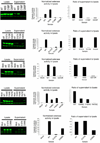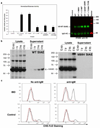Functionally defective germline variants of sialic acid acetylesterase in autoimmunity
- PMID: 20555325
- PMCID: PMC2900412
- DOI: 10.1038/nature09115
Functionally defective germline variants of sialic acid acetylesterase in autoimmunity
Abstract
Sialic acid acetylesterase (SIAE) is an enzyme that negatively regulates B lymphocyte antigen receptor signalling and is required for the maintenance of immunological tolerance in mice. Heterozygous loss-of-function germline rare variants and a homozygous defective polymorphic variant of SIAE were identified in 24/923 subjects of European origin with relatively common autoimmune disorders and in 2/648 controls of European origin. All heterozygous loss-of-function SIAE mutations tested were capable of functioning in a dominant negative manner. A homozygous secretion-defective polymorphic variant of SIAE was catalytically active, lacked the ability to function in a dominant negative manner, and was seen in eight autoimmune subjects but in no control subjects. The odds ratio for inheriting defective SIAE alleles was 8.6 in all autoimmune subjects, 8.3 in subjects with rheumatoid arthritis, and 7.9 in subjects with type I diabetes. Functionally defective SIAE rare and polymorphic variants represent a strong genetic link to susceptibility in relatively common human autoimmune disorders.
Figures



References
Publication types
MeSH terms
Substances
Grants and funding
- AI 064930/AI/NIAID NIH HHS/United States
- RC1 AR058481/AR/NIAMS NIH HHS/United States
- AR 044422/AR/NIAMS NIH HHS/United States
- AI 076505/AI/NIAID NIH HHS/United States
- AI 068759/AI/NIAID NIH HHS/United States
- N01 AR022263/AR/NIAMS NIH HHS/United States
- R01 NS032765/NS/NINDS NIH HHS/United States
- R01 AI076505/AI/NIAID NIH HHS/United States
- R01 AI068759/AI/NIAID NIH HHS/United States
- NS 32765/NS/NINDS NIH HHS/United States
- AR 058481/AR/NIAMS NIH HHS/United States
- R01 AR044422/AR/NIAMS NIH HHS/United States
- AR 022263/AR/NIAMS NIH HHS/United States
- R01 AI064930/AI/NIAID NIH HHS/United States
- P30 DK043351/DK/NIDDK NIH HHS/United States
LinkOut - more resources
Full Text Sources
Other Literature Sources
Medical
Molecular Biology Databases

